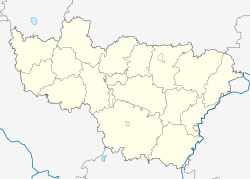Suzdal'
| Suzdal (in English) Суздаль (Russian) |
|
|---|---|
| - Town - | |
 Domes of the Nativity of the Virgin Cathedral |
|
 Location of Vladimir Oblast in Russia |
|
|
|
|
|
|
|
|
|
|
| Town Day | 2nd Saturday of August |
| Administrative status (as of September 2013) | |
| Country | Russia |
| Federal subject | Vladimir Oblast |
| Administrative district | Suzdalsky District |
| Administrative center of | Suzdalsky District |
| Municipal status (as of August 2009) | |
| Municipal district | Suzdalsky Municipal District |
| Urban settlement | Suzdal Urban Settlement |
| Administrative center of | Suzdalsky Municipal District, Suzdal Urban Settlement |
| Head of Town | Igor Kehter |
| Statistics | |
| Area | 15 km2 (5.8 sq mi) |
| Population (2010 Census) | 10,535 inhabitants |
| Population (2015 est.) | 9,978 inhabitants |
| Density | 702/km2 (1,820/sq mi) |
| Time zone | MSK (UTC+03:00) |
| Founded | 1024 |
| Postal code(s) | 601291, 601293 |
| Dialing code(s) | +7 49231 |
|
|
|
| on | |
| 2010 Census | 10,535 |
|---|---|
| 2002 Census | 11,357 |
| 1989 Census | 12,063 |
| 1979 Census | 11,529 |
Suzdal (Russian: Суздаль; IPA: [ˈsuzdəlʲ]) is a town and the administrative center of Suzdalsky District in Vladimir Oblast, Russia, located on the Kamenka River, 26 kilometers (16 mi) north of the city of Vladimir, the administrative center of the oblast. As of the 2010 Census, its population was 10,535.
Suzdal is one of the oldest Russian towns. In the 12th century it became the capital of the principality, with Moscow being merely one of its subordinate settlements. Nowadays Suzdal is the smallest of the Russian Golden Ring towns with population of just 9978 (2015), but a major tourist attraction. Several of its monuments are listed as UNESCO World Heritage Sites.
The town's history dates back to 1024 and in 1125 Yury Dolgoruky made Suzdal the capital of the Rostov-Suzdal principality. Suzdal began to function as a capital at the time when Moscow was still a cluster of cowsheds. In 1157 Andrei Bogolyubsky moved the capital from Suzdal to Vladimir, from which time the principality was known as Vladimir-Suzdal. Set in a fertile wheat-growing area, Suzdal remained a trade centre even after Mongol-led invasions. Eventually, it united with Nizhny Novgorod until both were annexed by Moscow in 1392.
...
Wikipedia



